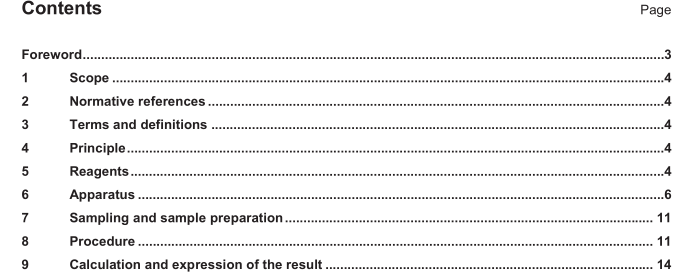EN 15559:2009 – Fertilizers – Determination of nitric and ammoniacal nitrogen according to Arnd

1 Scope
This European Standard specifies a method for the determination of nitric and ammoniacal nitrogen with reduction according to Arnd (modified for each of the variants a, b and c).
The method is applicable to all nitrogenous fertilizers, including compound fertilizers, in which nitrogen is found exclusively in nitrate form, or in ammoniacal and nitrate form.
2 Normative references
The following referenced documents are indispensable for the application of this document. For dated references, only the edition cited applies. For undated references, the latest edition of the referenced document (including any amendments) applies.
EN 1482-2, Fertilizers and liming materials — Sampling and sample preparation — Part 2: Sample preparation
EN 12944-1:1999, Fertilizers and liming materials and soil improvers — Vocabulary — Part 1: General terms
EN 12944-2:1999, Fertilizers and liming materials and soil improvers — Vocabulary — Part 2: Terms relating to fertilizers
EN ISO 3696:1995, Water for analytical laboratory use — Specification and test methods (ISO 3696:1987)
3 Terms and definitions
For the purposes of this document, the terms and definitions given in EN 12944-1:1999 and EN 12944-2:1999 apply.
4 Principle
Reduction of nitrates and nitrites to ammonia in a neutral aqueous solution by means of a metallic alloy composed of 60 % Cu and 40 % Mg (Arnd’s alloy) in the presence of magnesium chloride.
Distillation of the ammonia and determination of the yield in a known volume of standard sulfuric acid solution.
Titration of the excess acid by means of a standard solution of sodium or potassium hydroxide.
5 Reagents
5.1 General
Use only reagents of recognized analytical grade and distilled or demineralized water, free from carbon dioxide and all nitrogenous compounds (grade 3 according to EN ISO 3696:1995).
5.2 Diluted hydrochloric acid
Mix one volume of concentrated hydrochloric acid solution, ρ (HCl) = 1,18 g/ml, with one volume of water.
5.3 Sulfuric acid (for variant a), c = 0,05 mol/l.
5.4 Sodium or potassium hydroxide solution (for variant a), carbonate free, c = 0,1 mol/l.
5.5 Sulfuric acid (for variant b, see NOTES in 8.2), c = 0,1 mol/l.
5.6 Sodium or potassium hydroxide solution (for variant b, see NOTES in 8.2), carbonate free,c = 0,2 mol/l.
5.7 Sulfuric acid (for variant c, see NOTES in 8.2), c = 0,25 mol/l.
5.8 Sodium or potassium hydroxide solution (for variant c, see NOTES in 8.2), carbonate free,c = 0,5 mol/l.
5.9 Sodium hydroxide solution , approximately c = 2 mol/l.
5.10 Arnd’s alloy , powdered so as to pass through a sieve with apertures less than 1 mm square.
5.11 Magnesium chloride solution , ρ = 20 %.
Dissolve 200 g of magnesium chloride (MgCl 2 . 6H 2 O) in approximately 600 ml to 700 ml of water in a 1 l flatbottomed flask. To prevent frothing, add 15 g of magnesium sulfate (MgSO 4 .7H 2 O).
After dissolution add 2 g of magnesium oxide and a few anti-bump granules of pumice stone and concentrate the suspension to 200 ml by boiling, thus expelling any trace of ammonia from the reagents. Cool, make up the volume to 1 l and filter.
5.12 Indicator solutions
5.12.1 Mixed indicator
Solution A: Dissolve 1 g of methyl red in 37 ml of sodium hydroxide solution c = 0,1 mol/l and make up to 1 l with water.
Solution B: Dissolve 1 g of methylene blue in water and make up to 1 l.
Mix one volume of solution A with two volumes of solution B.
This indicator is violet in acid solution, grey in neutral solution and green in alkaline solution. Use 0,5 ml (10 drops) of this indicator solution.
EN 15559:2009 – Fertilizers – Determination of nitric and ammoniacal nitrogen according to Arnd